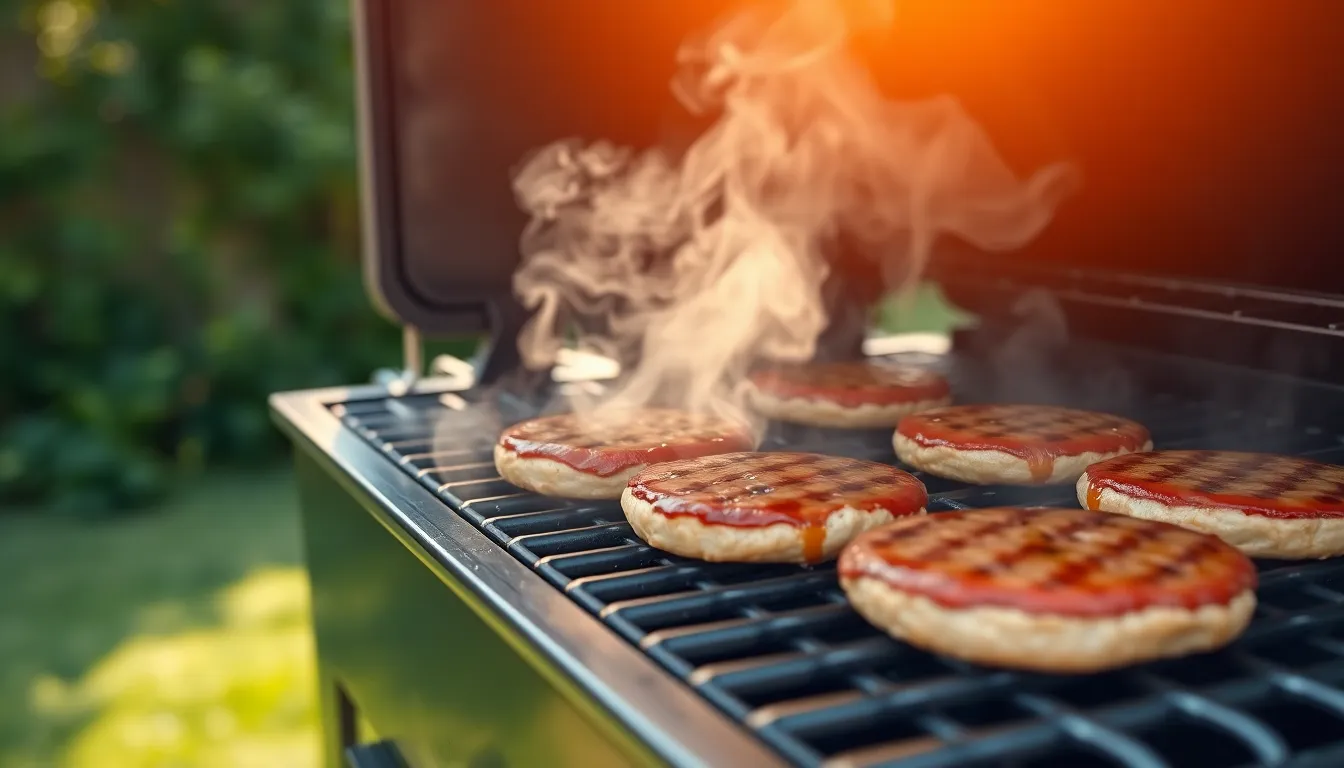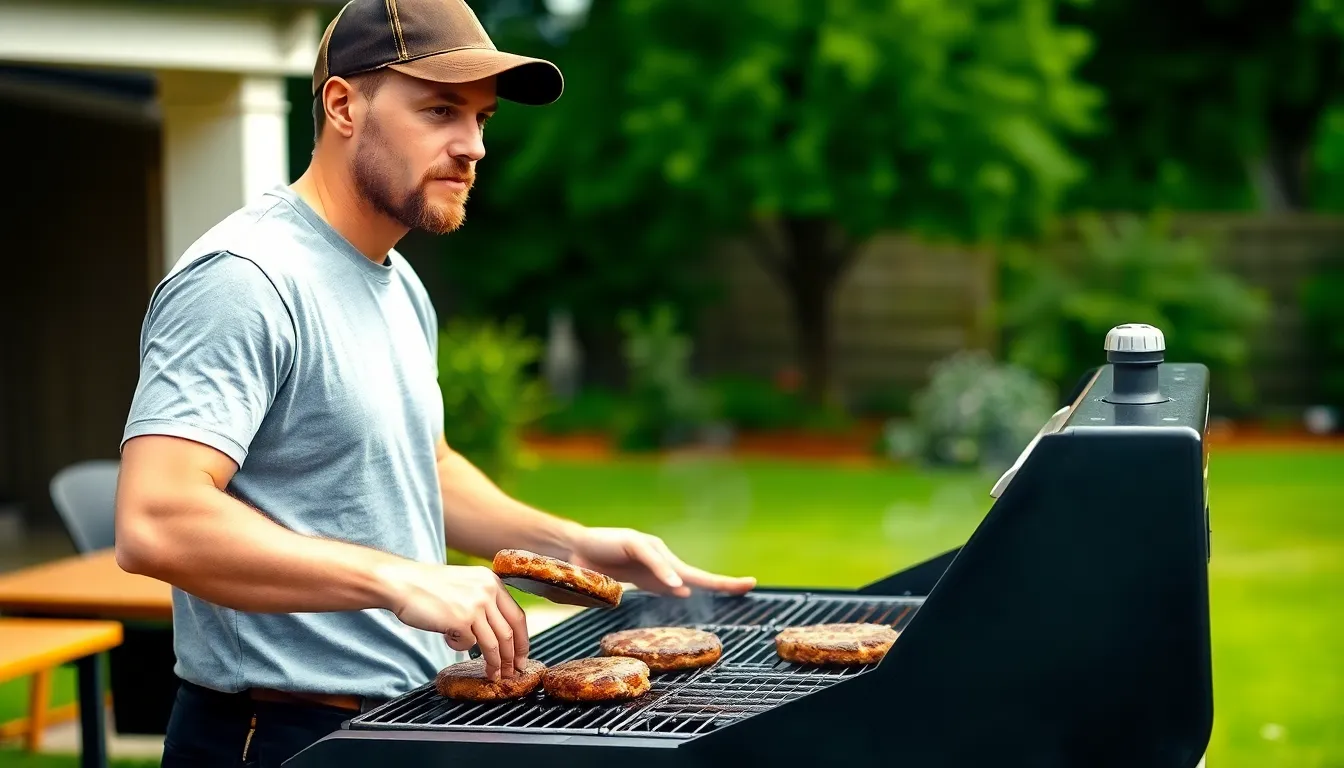Table of Contents
ToggleGrilling the perfect burger isn’t just a culinary skill; it’s an art form. Picture this: a juicy patty sizzling on the grill, sending mouthwatering aromas wafting through the air. But hold on! Before you dive into that grilling frenzy, you need to master the secret sauce of temperature and timing.
Let’s face it, no one wants a burger that’s as dry as a desert or so rare it might moo at you. Finding the sweet spot between undercooked and overdone can turn a backyard barbecue into a culinary catastrophe. With the right grill temp and timing, you’ll serve up burgers that’ll have everyone coming back for seconds—maybe even thirds! So, grab your apron and get ready to flip some patties like a pro.
Understanding Burger Grill Temp and Time
Grilling burgers requires knowledge of temperature and timing. Mastering these elements ensures burgers are juicy and safe to eat.
Importance of Proper Cooking
Proper cooking is vital for food safety and flavor enhancement. Burgers must reach an internal temperature of 160°F to eliminate harmful bacteria like E. coli. Uneven cooking can lead to dry, overcooked edges and cold centers. The right temperature creates a flavorful crust while keeping patties juicy. Using a meat thermometer provides accurate readings. This tool ensures that every patty cooked maintains quality and safety.
Common Myths and Misconceptions
Several myths surround burger grilling techniques. Some believe that higher temperatures always yield better results. That isn’t true; lower temps often improve juiciness and tenderness. Another misconception is that pressing down on burgers helps them cook faster. This action actually squeezes out flavorful juices, making burgers dry. Many think that all ground beef is the same. In reality, fat content affects both flavor and cooking time. Understanding these myths helps achieve the perfect grill outcome.
Ideal Grill Temperatures

Grilling burgers requires an understanding of ideal temperatures for optimal results. Mastering these temperatures enhances both the taste and safety of the burgers.
For Different Types of Burgers
Ground beef typically requires a grilling temperature of 350°F to 400°F. Turkey and chicken burgers often grill best at around 375°F, allowing for thorough cooking without drying out. Veggie burgers might need slightly lower temperatures, around 300°F to 350°F, to prevent burning while ensuring they cook through. Each burger type benefits from its specific temperature range, ensuring flavors develop and textures remain appealing.
How Thickness Affects Cooking Time
Burger thickness significantly influences cooking time. Thicker patties, measuring 1 inch or more, usually require about 7 to 8 minutes per side at medium heat. Conversely, thinner patties, around ½ inch, generally cook in 3 to 4 minutes per side. Monitoring internal temperature is crucial, as thicker burgers often require more attention to reach the ideal 160°F for safety. Adjusting cooking time based on thickness helps ensure each burger is perfectly cooked.
Time Guidelines for Grilling Burgers
Grilling burgers requires attention to cooking times for optimal results. Knowing the right duration ensures juicy, delicious patties every time.
Recommended Cooking Times for Each Temperature
At 350°F to 400°F, ground beef burgers typically cook in 7 to 8 minutes per side. Turkey and chicken burgers fare best around 375°F, needing about 6 to 7 minutes per side. Veggie burgers, often a bit thinner, generally take 4 to 5 minutes per side at 300°F to 350°F. Thicker patties may require additional time, while thinner ones will cook more quickly. Always adjust based on specific grill performance to achieve perfect results.
Tips for Checking Doneness
Using a meat thermometer is the most reliable way to check burger doneness. Insert it in the thickest part of the patty; it should read 160°F for safe consumption. Alternatively, visual cues can also indicate doneness: juices should run clear, and a firm texture suggests a well-cooked burger. Avoid pressing down on patties, as this can release flavorful juices. Testing multiple burgers is wise, especially for thicker options, to ensure every serving meets food safety standards.
Techniques for Perfectly Grilled Burgers
Grilling burgers to perfection involves specific techniques that enhance flavor and ensure safety. Mastering these techniques leads to delicious results without compromising quality.
Use of Thermometers
Using a meat thermometer is essential for achieving perfectly cooked burgers. A thermometer provides an accurate reading of internal temperature, ensuring safety by reaching 160°F for ground beef, turkey, and chicken. Many people mistakenly rely on cooking time alone, but this can result in undercooked patties. Placing the thermometer in the thickest part of the patty gives the most reliable indication of doneness. Consistently checking temperature allows for adjustments in cooking time to ensure ideal results.
The Resting Period
Allowing burgers to rest before serving improves flavor and texture. During this resting period, juices redistribute throughout the patty, enhancing moisture in each bite. Typically, a resting time of five minutes suffices after grilling. Patience pays off, as cutting into the burger too early can cause precious juices to escape, resulting in dryness. Covering burgers with foil while they rest retains heat and maintains an optimal serving temperature. Ensuring that the burgers rest will elevate the overall dining experience.
Grilling the perfect burger is an achievable goal with the right knowledge of temperature and timing. By understanding the ideal grill temperatures and cooking times for various types of burgers, anyone can elevate their grilling game. Utilizing a meat thermometer is essential for ensuring safety and achieving that juicy, flavorful patty.
After grilling, allowing burgers to rest enhances their moisture and flavor, making for a truly satisfying meal. With these tips in hand, anyone can impress friends and family at their next barbecue with perfectly cooked burgers that are both safe and delicious.




